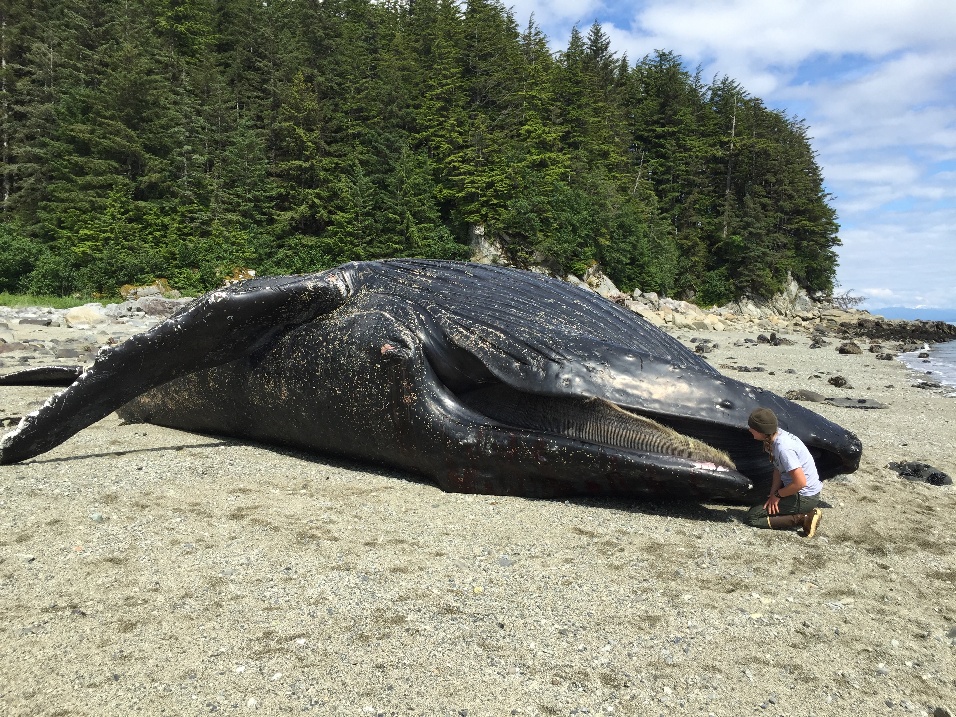|
You are viewing ARCHIVED content published online before January 20, 2025.
Please note that this content is NOT UPDATED, and links may not work. For current information,
visit https://www.nps.gov/aboutus/news/index.htm.

Contact: Chris Gabriele, Whale Biologist, 907-697-2664 Contact: Tom VandenBerg, Chief of Interpretation, 907-697-2619 BARTLETT COVE, ALASKA –A dead humpback whale was found floating near the mouth of Glacier Bay on June 26th and was towed to shore and secured by Glacier Bay National Park staff. On June 28th, veterinary pathologist Dr. Stephen Raverty led a team of biologists and volunteers who examined the carcass to determine the cause of death and collected samples for laboratory diagnostics and natural history studies. Although there were large areas of bruising and bleeding in the mouth suggestive of acute physical injury, the team found no evidence of skull or other bone fractures. There were indications that the whale was in poor health. Lymph nodes at the back of the throat were enlarged and consistent with secondary bacterial infection. Diminished fat stores were noted in the blubber. Externally, the whale had an unusually heavy infestation of cyamid "whale lice," a parasite that commonly lives on whale skin. Park whale biologist Christine Gabriele said that elevated numbers of whale lice are often associated with injury or poor health, such as on whales that have been entangled in fishing gear for weeks or months. The dead whale showed no evidence of recent entanglement. Tissue samples were also collected to evaluate the whale's exposure to harmful algae toxins, such as domoic acid and saxitoxin, the latter of which is also responsible for paralytic shellfish poisoning (PSP) in humans. Results of the laboratory analyses will be available in 4-6 weeks, but overall Raverty said, "It appears that the poor nutritional condition of this whale may have predisposed it to physical injury." Laboratory analysis of the tissue samples conducted in the coming weeks will further illuminate the cause of death and provide invaluable baseline health information for the population. In the early 1970s, the 45.6 foot adult male humpback was nicknamed Festus, (Southeast Alaska Catalog #441) by researcher Charles Jurasz, because it "festooned itself with kelp" while he observed it in Glacier Bay. Festus was last sighted alive in June 2015 in Glacier Bay. With a 45-year sighting history, Festus was the longest-sighted humpback whale that has yet been recorded in Southeast Alaska. Glacier Bay biologists work collaboratively with other Alaska and Hawaii researchers to maintain life history records of individual humpback whales. Gabriele said that because Festus was not a calf when he was first sighted, we don't know how old he was. However, the whale's waxy earplug was collected to estimate its age, evaluate life history events, and lifetime contaminant exposure. Old age may have been a contributing factor to Festus's death, but Gabriele noted that several whales in the Glacier Bay area and elsewhere in Southeast Alaska have been documented to be in poor body condition this summer. "With a practiced eye, a whale biologist can determine if a whale is thin, if the shoulder blades or ribs are visible, or if the fat roll behind the blowholes is reduced or absent." In addition, very few calves were documented in the Glacier Bay area in 2015, and only one calf has been documented so far in 2016. "In a typical summer, by July, we have seen ten or more calves in Glacier Bay and Icy Strait." She speculated that poor feeding conditions in 2014 and 2015 associated with the strong El Niño and the warm water "blob" in the North Pacific may be showing their effects on whale health and reproduction. Visitors who view the carcass are reminded that Park regulations prohibit disturbing wildlife, including animals that may be feeding on the carcass. Visitors who choose to go ashore at the site are cautioned that bears may be present. Under the Endangered Species Act, Marine Mammal Protection Act, and National Park Service regulations, the general public is prohibited from collecting marine mammal parts in Glacier Bay National Park. Park wildlife biologists have placed a time lapse and motion sensor camera near the carcass to monitor the natural decomposition and activity of scavengers. Highlights of these photos will be shared with the public via Glacier Bay social media. Click here for a printer-friendly version of this news release, with additional photographs. Learn more about humpback whales in Glacier Bay |
Last updated: February 9, 2018
